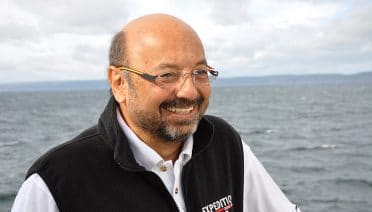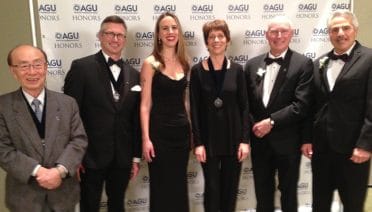Press Room
Admiral Jonathan Greenert, the Chief of Naval Operations, visited Woods Hole Oceanographic Institution (WHOI) Nov. 6 for firsthand discussions with scientists and engineers conducting research and building technology with potential to enhance Naval capabilities and operations.
Monitoring efforts along the Pacific Coast of the U.S. and Canada have detected the presence of small amounts of radioactivity from the 2011 Fukushima Dai-ichi Nuclear Power Plant accident 100 miles (150 km) due west of Eureka, California. Scientists at the Woods Hole Oceanographic Institution (WHOI) found the trace amounts of telltale radioactive compounds as part of their ongoing monitoring of natural and human sources of radioactivity in the ocean.
Earth is known as the Blue Planet because of its oceans, which cover more than 70 percent of the planet’s surface and are home to the world’s greatest diversity of life. While water is essential for life on the planet, the answers to two key questions have eluded us: where did Earth’s water come from and when?
Nearly five years after the Deepwater Horizon explosion spilled roughly 200 million gallons of oil into the Gulf of Mexico, scientists are still working to answer the question: Where did all the oil go?
A paper published today in the Proceedings of the National Academy of Sciences provides a piece of the puzzle with an analysis of the oil that ended up on the seafloor, establishing its footprint, rough quantity and likely deposition mode, and pegging its source to that deep ocean plume of oil.
A Greek and international team of divers and archaeologists has retrieved stunning new finds from an ancient Greek treasure ship that sank more than 2000 years ago off the remote island of Antikythera. The rescued antiquities include tableware, ship components, and a giant bronze spear that would have belonged to a life-sized warrior statue.
The Explorers Club has chosen David Gallo, Director of Special Projects at the Woods Hole Oceanographic Institution (WHOI), as one of the recipients of this year’s Lowell Thomas Award. He is among six recipients who will be honored for their “imagination in exploration” at a dinner on October 11, 2014, at the Bowers Museum in Southern California.
Woods Hole Oceanographic Institution (WHOI) researchers are part of a collaborative effort to understand and monitor changes in marine biodiversity within U.S. coastal waters. Marine biodiversity is a key indicator of ocean health and critical to sustaining natural resources such as fisheries.
The human-occupied sub Alvin was the “guest of honor” this week at House and Senate staff briefings and a reception at the U.S. Capitol, commemorating 50 years of service as our nation’s deepest diving research submersible. A contingent of scientists…
For decades, medical researchers have sought new methods to diagnose how different types of cells and systems in the body are functioning. Now scientists have adapted an emerging biomedical technique to study the vast body of the ocean. In a…
Rapid climate change and an increasing range of climate impacts are already being felt along our coasts, and new research suggests that U.S. Northeast coastal waters may be more vulnerable to climate change and ocean acidification than previously thought. How…
Eight writers, filmmakers, and multimedia science journalists from the U.S., England, and The Gambia have been selected to participate in the competitive Woods Hole Oceanographic Institution (WHOI) Ocean Science Journalism Fellowship program. The program takes place September 7-12, 2014, in…
Woods Hole Oceanographic Institution (WHOI) scientists Rockwell Geyer, Susumu Honjo, and Delia Oppo have been elected 2014 fellows of the American Geophysical Union (AGU).
When a team from the Woods Hole Oceanographic Institution (WHOI) took a specially equipped REMUS SharkCam underwater vehicle to Guadalupe Island in Mexico to film great white sharks in the wild, they captured more than they bargained for.
Although the days of odd behavior among hat makers are a thing of the past, the dangers mercury poses to humans and the environment persist today. Mercury is a naturally occurring element as well as a by-product of such distinctly…
The co-star of the James Cameron’s latest film is not your typical Hollywood starlet. She’s 24-feet long, bright green and weighs approximately 11.8 tons. The one-of-a-kind, deep-diving submersible DEEPSEA CHALLENGER will travel from its home at the Woods Hole Oceanographic…
Whale sharks (Rhincodon typus)—which grow more than 30 feet long—are the largest fish in the world’s ocean, but little is known about their movements on a daily basis or over years. A newly discovered juvenile whale shark aggregation off Saudi Arabia is giving researchers a rare glimpse into the lives of these gentle giants.
A new study by scientists at Haverford College and Woods Hole Oceanographic Institution (WHOI) has found that the dispersant compound DOSS, which decreases the size of oil droplets and hampers the formation of large oil slicks, remains associated with oil and can persist in the environment for up to four years.
This summer, Woods Hole Oceanographic Institution’s “Science Made Public” series celebrates the deep-diving submersible Alvin’s 50 years in operation. A venerable giant in deep ocean research, Alvin has logged many accomplishments over the years, from discovering hydrothermal vents to exploring the…
The Woods Hole Oceanographic Institution has appointed James Bellingham as the first director of its Center for Marine Robotics. Bellingham will come to WHOI in early fall 2014 from the Monterey Bay Aquarium Research Institute (MBARI), where he was director…
Mainly thought to be surface dwellers, Chilean devil rays (Mobula tarapacana) are most often seen gliding through shallow, warm waters. But a new study by scientists at Woods Hole Oceanographic Institution (WHOI) and international colleagues reveals that these large and majestic creatures are actually among the deepest-diving ocean animals.


